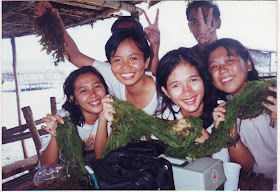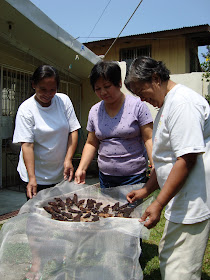A Pocket Tropical Rainforest in the City
Dr Abe V Rotor
 Towering dita (Alstonia scholaris), UST Botanical Garden
Towering dita (Alstonia scholaris), UST Botanical Garden
What really makes a beautiful garden may draw to school of thought- Romanticism and functionalism. The University of Santo Tomas botanical garden does not take side in the issue; it portrays both in an integrated, harmonious design patterned after the richest and the most enviable biome on earth- the tropical rain forest.
The new face of the garden is striking. Let us begin with the cascading 6- foot waterfall and trace its flow on a meandering rocky stream that ducks under a footbridge before plunging into the depth of a pond, its bottom murky and cool and rich in detritus. Here calms and snails, and other bottom dwellers, mostly decomposers, reside, shy from the sun and remain ensconced in the very food source that settles down. Such in the niche of these sessile, benthic organisms.
Bryophyte Garden
Along the “river”, the water keeps the environment fresh and cool, lapping at the rock, sending spray on its banks. Through time, on the walls of the waterfall and on any rocks that lies across the path of water, grow countless kinds of algae and mosses that build layer after layer until a carpet is formed, thus giving rise to another niche- the domain of bryophytes in Lilliputian imagery, or one depicted in the movie, “ Honey, I shrunk the kids”.
Bryophytes are among the earliest plants and are, therefore, primitive. It is as if we are turning the hands of time some two billion years ago or so, when these prototypes began to fill the atmosphere with oxygen, which later favored the growth of more, advanced vegetation. Perhaps their most outstanding contribution is in oil building, breaking up rocks exfoliating them, virtually skinning them with their acidic foothold, and, together with their biomass, making a mass we call soil.
Micro- Climate Effect
The ultimate source of water is the sky, from the clouds that gather and grow atop the forest. Transpiration and evaporation combine to attract the clouds, which come down as a shower or a downpour at any time of the day or night. It is for this phenomenon that this biome got its to simulate this condition, the waterfall and running streams, together with a large fountain and a series of ponds near by, maintain high humidity in the area that is the key to the formation of a multi- story vegetation and myriad of resident organisms.
It will take time for the UST botanical garden to reach the status of a true typical rainforest. Years shall pass, and in the process students and visitors shall witness here, the transformation of one sere after, until a climax community is formed. It is not only for the scientific and aesthetic aspect that count; it is for something more - that which presents itself in the realm of ethico- morals that governs man in his role in God’s creation- the transformation of man himself as a true and faithful steward.
Evolving Ecosystem
 Orchids find a home on the trunk of big trees without harming them.
Orchids find a home on the trunk of big trees without harming them.
The UST botanical garden is being transformed as a deliberate expression of an evolving ecosystem. It is Nature’s laboratory and a playing field of biological diversity.
Environment: A Pocket Tropical Rainforest in the City
As a field laboratory the garden demonstrates ecological cycles- invasion, colonization, competition, and emergence of dominant species as well as seasonal and long term succession patterns. We may not have the four distinct seasons, but there are tropical trees that demonstrate some characteristics they carry in their ancestral genes, such as deciduousness in narra ( Ptercarpus inducus), our national tree.
The garden is a living manifestation of dynamic balance in a changing environment with the organisms constantly adjusting to the demands of the latter, but in the process slowly affecting the environment itself. Such transformational stages, called seres, always lead towards homeostasis, and the result is a climax ecological system.
As a showcase of natural habitats, the garden adjusts to the development of niches and diversity indices. The garden never sleeps, to speak. It is a living arena and the drama of life goes on and on.
When we look at a life, we look at it in physics and chemistry- the flow of energy through the food chain, food web and their heirarchic order, the food pyramid. The light energy of the sun is transformed into chemical energy in plants, and is passed on to various organisms, one after another through the links of a chain. The remaining energy is used by the decomposers that transform organic substances into inorganic forms for the use of the next generation organisms- and the cycle goes on and on. We can witness this phenomenon among the residents in the pond, and among insects, arachnids, birds, and reptiles that reside nearby.
The garden is a laboratory for sociobiology, in the words of the founder of this field, E.O. Wilson. Animal behavior is demonstrated both by instinct and condition learning, and, to an extent, incipient intelligence. The ingenious building of a spider’s web, the predatory, awes student’s techniques of the preying mantis and the green tree ant. But this study may go into the physiologic responses in plants - tropism or reactions to light, touch, and the other elements. Plants, to sociobiologists, are not insensitive and incapable of communicating with one another. As members of a community, they, too, respond, singly and collectively, through some kind of communication medium.
There are biological indicators of the state of the environment. The garden has a host of these indicators, such as lichens and fireflies, the presence of which attests to the fact that the environment is tolerably favorable to them in spite of air pollution, and that the garden has become their home. The garden itself is also a barometer of climatic adversity life El Niño. The flowering of the bamboo is an antecedent of its episode.
I believe that, in spite of the crowded environment of high rise buildings around the UST, the Botanical Garden is not without natural populations of species, such as butterflies. Having the kinds of plants they feed on and rear they young, the garden is their natural abode. The ponds are a sanctuary of dragonflies as well, and their waters teem with both phytoplankton and zooplankton, seen only under the microscope. These in turn key up the food web, linking one organism to another in an amazing network of interrelationship.
"As a gene bank, the garden is a depository of biological diversity, providing access to genetic studies, propagation and exchange with other institutions," says Dr. Anselmo S. Cabigan a well known biologist and ecologist. The UST Botanical Garden is being supervised by Dr. Romualdo M del Rosario.~
 Fire tree (Delonix regia) - its full summer bloom -
Fire tree (Delonix regia) - its full summer bloom -















































